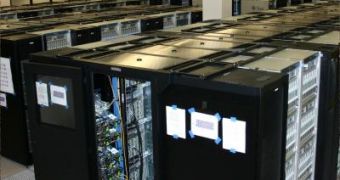University of Texas recently unveiled Ranger, world's second most powerful supercomputer. The high-performance computing cluster was built by Sun and is comprised of 15,744 quad-core AMD Opteron processors for a total of 62,976 cores, 123 terabytes of memory and 1.7 petabytes of storage.
According to David Rich, a spokesman for Advanced Micro Devices, Ranger is the second most powerful supercomputer in the world, although its validation will be effective as of the date the biannual Top 500 supercomputer list is released.
Ranger can reach a peak computing performance of roughly 504 teraflops, or 500 trillion floating-point operations per second. In contrast, the world's mos powerful supercomputer, the IBM BlueGene/L at the Lawrence Livermore National Laboratory, can reach a peak speed of 596 teraflops.
"It's really exciting. It's really all about the science that people can do," said Karl Schulz, associate director for high-performance computing at the Texas Advanced Computing Center. "Here you've got a research instrument that you don't have to hold back on what you want to do. This really could change what researchers do across the country. Someone could run 30,000 cores at once, and at the same time, we could run a bunch of 1,000 core jobs simultaneously."
The computer was born from a joint effort between the National Science Foundation (NSF) and the Texas Advanced Computing Center. As part of the signed agreement with the NSF, the University will grant access to the supercomputer's resources to any researcher in the U.S. that has previously applied for computing time. The applications will be reviewed by a national committee of academics, and the accepted researchers will be able to use the computer for free. Schulz claims that 100 million hours of computing time have been requested so far, while 400 researchers have already been accepted.
"We are still gearing up, but we are starting to get exciting results," said Volker Bromm, an assistant professor in the astronomy department at the University of Texas in Austin. "We need to simulate a huge piece of the universe. ? It's a very demanding problem, and up to this point it could not have been done with any machines we had. With the additional boost of power that Ranger has, we can, for the first time, bridge the gap between the huge scales of the universe down to something as small as the solar system."
Professor Bromm is researching on the Cosmic Dark Ages, a period of time that preceded the creation of the first stars or galaxies.
"We can probe most of the history of the universe, but the Cosmic Dark Age period is really the final missing gap of our world view," he added. "We're making predictions by taking the initial conditions from the Big Bang. We feed this [information] into the computer and watch evolution for hundreds of millions of years, and we watch the formation of the first stars and galaxies. Ranger is a time machine."
The supercomputer costs about $30 million to build and deploy, but the government estimates that its ownership costs will reach some other $29 million.

 14 DAY TRIAL //
14 DAY TRIAL //